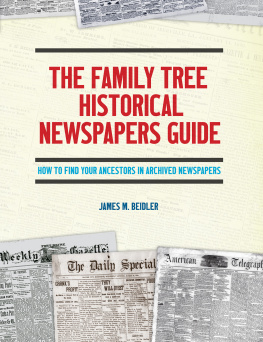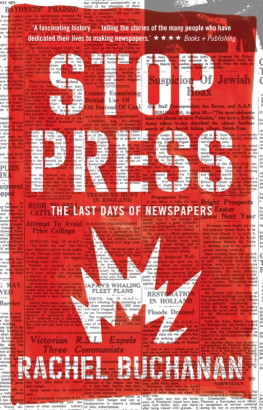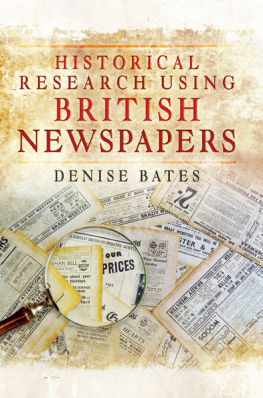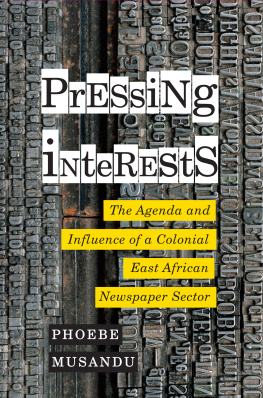This work is the culmination of my somewhat tumultuous relationship with the provincial newspaper. For many years this was the environment within which I worked as a journalist, and it was here that I grew to love the all-encompassing view of life which it afforded. At the same time though my colleagues and I were subject to the strictures of a working environment which was being squeezed by the quest for everlasting shareholder payouts. We worked longer and longer hours, with fewer and fewer staff, but such was our professional pride that we were driven to produce the best papers we could. Despite this it was personal circumstance, rather than disillusion, which prompted my move to academe and afforded me the opportunity to reflect on my experience as a working journalist. This work began there, as a kind of a quest; the search for the halcyon days of the provincial newspaper a time when its operation was dedicated to the public interest watchdog role, which had been inculcated into me via training and my newsroom acculturation. But instead of finding a high point against which decline could be measured, I discovered an industry which had always been just that an industry, focused on turning a profit, for which the public interest was little more than a stance to add legitimacy to its economic intent.
Surprisingly I also discovered that to date there is no singular study which considers the development of the provincial paper over a sustained period of time. This says so much about the status accorded to these titles, despite their long-standing success as commercial products and their establishment as fixtures of the communal imagination. I recognize the ambition of my intent to address this gap.
However, rather than cataloguing where and how individual papers began and ended, I have concentrated on the development of the provincial newspaper as a specialist media form, aligned with a set of norms and practices which can be distinguished and charted over time. In doing so this study also seeks to rescue the study of the provincial newspaper industry from the amnesia which besets most contemporary considerations, which are cut off from this historic context. The contemporary landscape of disruption makes this approach particularly apposite. Following in the spirit of James Curran, this approach is driven by the contention that history and media studies are fundamentally connected insofar as one can only really begin to understand the contemporary media landscape if one knows something about how communication technologies and their social uses have changed over time (2002: 20). Where this study diverges from Curran, and his criticism of the medium history approach of most media history, is in its unashamed concentration on one media form. Curran suggests that a better approach is to offer a general history of the account of the development of modern British society in which the history of the British media is inserted to dissolve linear narratives whether they progress or regress in favour of complexity (ibid.: 149). However, this approach works best when all media are considered, and so this study seeks to establish the provincial press as an essential building block in this landscape and to engage with it as a discursive form. In doing so we can use history to challenge and analyse those constituent parts.
Of course any work of this scope owes a debt to the many people who assisted in its production. A special acknowledgement is due to Professor Bob Franklin, who has championed contemporary research into the provincial press. Similarly, Professor Martin Conboys early support lent encouragement to the project. Not least among those who deserve recognition are the many staff at the local archives and libraries around the country who have helped me piece together the often fragmentary evidence which remains in relation to the business of regional newspapers. Particular thanks are due to the Cumbria Archive Service, which facilitated my examination of the extensive holdings relating to the CN News group in Carlisle, and the Cumberland & Westmorland Antiquarian and Archaeological Society for their generous funding support for this stage of my study. I owe a particular debt to the document supply team at the Lanchester Library at Coventry University, for whom an obscure reference is seen as a challenge to be met with success. Similarly, I am grateful for my own institution, Coventry University, for the research sabbatical funding which enabled me to concentrate on the preparation of the final manuscript, and to my friends and colleagues whose encouragement has seen me over the finish line on more than one occasion. My family has in many ways lived and breathed the progress of this project for many years particularly my youngest child Gabriel, who is as old as it is. Finally, as a journalist I was taught that news is people and, in many ways, so is history even the history of a business. Behind this history lies the very real experience of all those who have worked to produce local and regional newspapers. Ultimately this work is dedicated to them.
Wiles covers 17001765, Black 16211861; Boyce et al. do scope newspaper history from the seventeenth century to the present day, but the chronological section is a consideration of press development as a whole rather than factions within it.
and Thomas (2006) for scoping studies of the structure of the local press in Scotland and Wales). Indeed, their increasing remoteness from the London-based press suggests an increased emphasis on the provincial press in these areas, and Tunstall (1996: 62) suggests that Scotland has traditionally resisted the dominance of the London press.
When film director Ridley Scott imagined a dystopian future in his 1982 film, Blade Runner , he made the cars fly, but put the hero on the street corner reading a printed broadsheet. At a local level, this translates to the notion of the daily or weekly newspaper as a faithful friend, the regular appearance of which is a ritualistic part of community life. This ubiquity though is a chimera; despite their apparent fixedness in the place in the cultural imagination, the newspaper whether at national or local level has never had an absolute presence, and currently its reach might be described as fragmentary at best. As I write, the circulations of printed newspapers are in such a continued and long-term state of decline that the dominant narrative surrounding their future is one of extinction. This is particularly so in the face of the impact of digital technology which has disrupted long-standing assumptions underpinning the perceived relationship between form, content and purpose.
It is this fragmentation which has prompted this retrospective look at the provincial press in England. Just as we are now more likely to search for a new house using the internet than via the pages of these papers, these titles are also available online, so that websites now outnumber printed products. Additionally The local press as a whole relates to those newspapers which define themselves as circulating within a defined geographical area; within this classification they are usually further subdivided to the regional press, which circulates across larger geographical areas such as English counties, meaning the local press is largely understood to focus on a town or district level.











